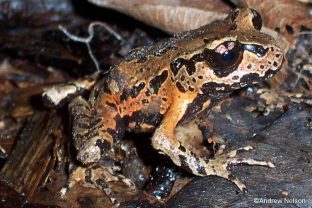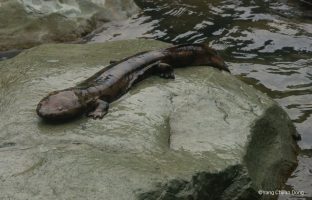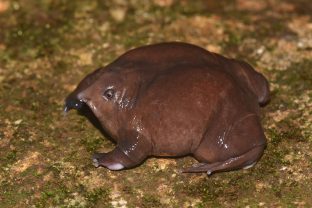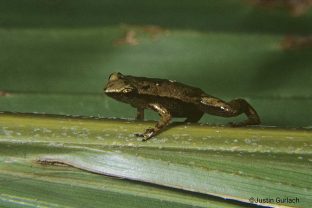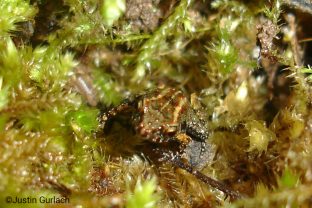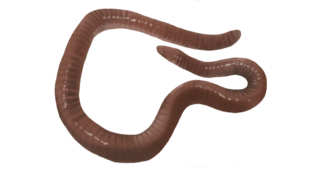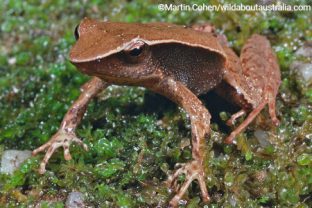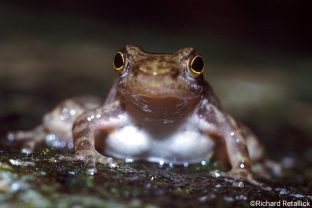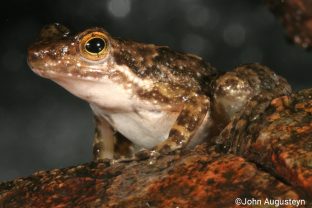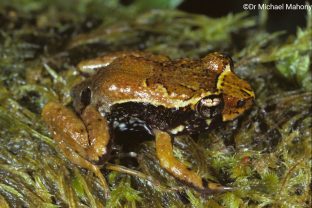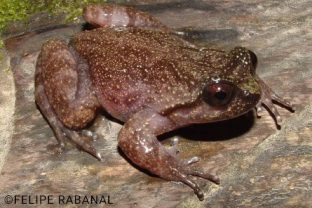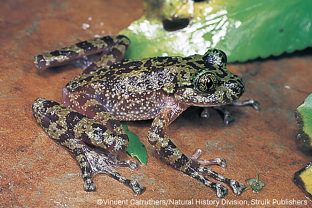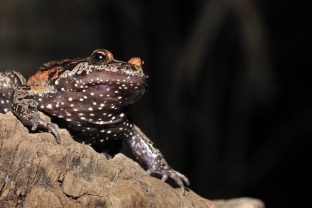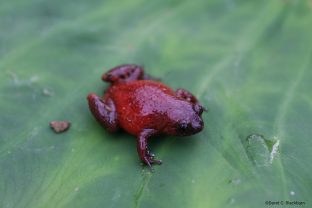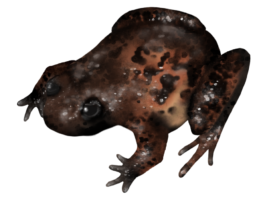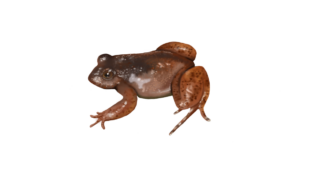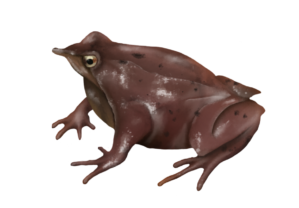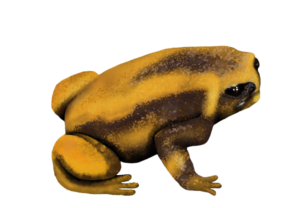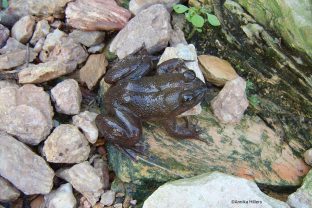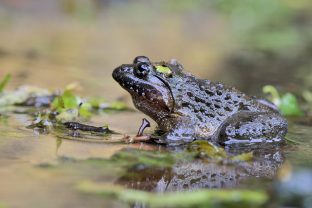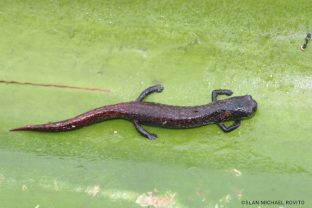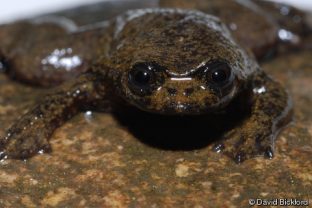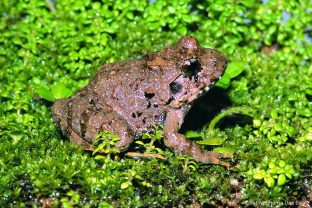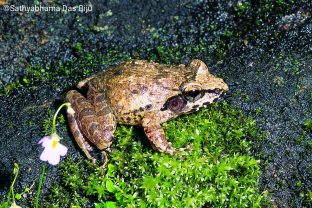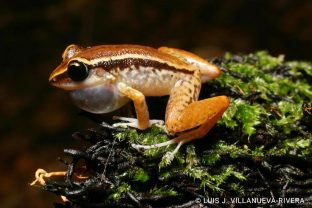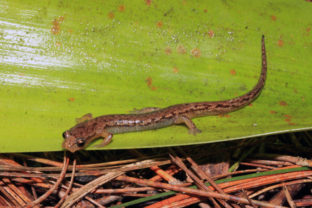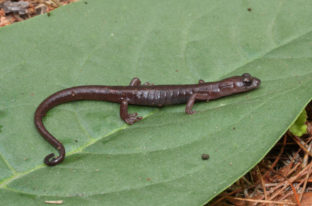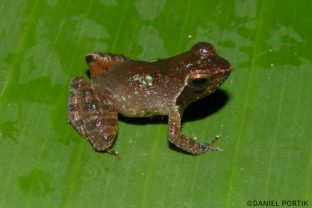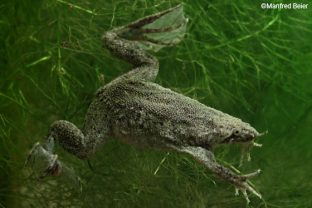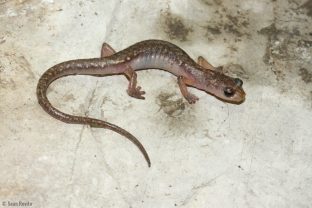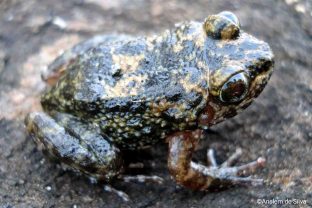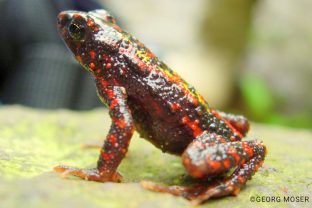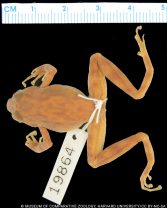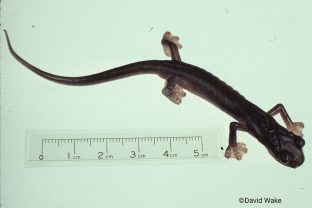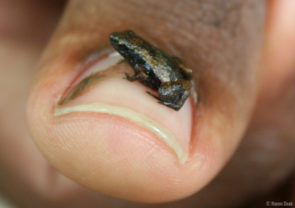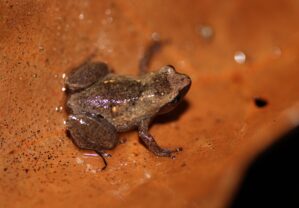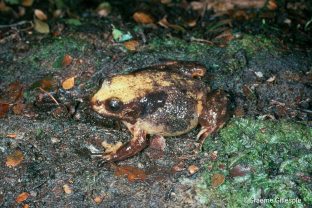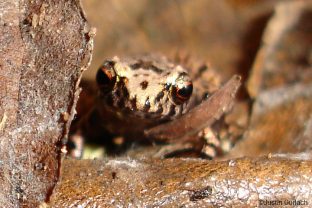TOP EDGE Amphibians
Archey’s Frog
Leiopelma archeyi
Archey’s frog is the world’s most Evolutionarily Distinct and Globally Endangered amphibian species.
Conservation Attention
Good
Chinese Giant Salamander
Andrias davidianus
The Chinese giant salamander is the world’s largest amphibian, growing up to 1.8 metres long, with a large tail comprising almost 60% of the body length.
Conservation Attention
Good
Purple Frog
Nasikabatrachus sahyadrensis
The purple frog (or pig-nosed frog) spends much of its life underground, emerging briefly for a few days each year at the start of the monsoons to breed.
Conservation Attention
Low
Seychelles Palm Frog
Sechellophryne pipilodryas
The Critically Endangered Seychelles palm frog was only described as a new species in 2002, and details of its breeding behaviour are currently unknown.
Conservation Attention
Very Low
Thomasset’s Seychelles Frog
Sooglossus thomasseti
Thomasset’s frog is the largest of the Seychelles’ native frogs, reaching a maximum length of 55 mm, and is Critically Endangered.
Conservation Attention
Low
Mount Oku Caecilian
Crotaphatrema lamottei
The Mount Oku caecilian occurs in an area of just 49km²!
Conservation Attention
Very Low
Sharp Snouted Day Frog
Taudactylus acutirostris
With only three individuals reported since 1994, there is doubt as to whether this species is still surviving in the wild.
Conservation Attention
Low
Eungella Day Frog
Taudactylus eungellensis
Until January 1985, this species was considered to be common across its range. However, it was at this time the first indications of decline were recorded, first at lower altitudes and then throughout the whole range.
Conservation Attention
Low
Kroombit Tinker Frog
Taudactylus pleione
The Kroombit tinker frog is a small frog from northeastern Australia that reaches lengths of only 2.5 cm.
Conservation Attention
Low
Northern Tinker Frog
Taudactylus rheophilus
The Critically Endangered Northern tinker frog is relatively small, growing to a maximum length of only 3 cm.
Conservation Attention
Low
Barrio’s Frog
Insuetophrynus acarpicus
Barrio’s frogs are powerful and fast moving, often jumping to the middle of a stream and seeking shelter under submerged stones or along the stream bank if threatened.
Conservation Attention
Very Low
Table Mountain Ghost Frog
Heleophryne rosei
The Critically Endangered Table Mountain ghost frog is found only on the slopes of Table Mountain, South Africa, occupying an area of only 4 km².
Conservation Attention
Medium
Hula Painted Frog
Latonia nigriventer
The Critically Endangered Hula painted frog, of Israel, was believed extinct until its rediscovery in November 2011.
Conservation Attention
Low
Redbelly Egg Frog
Leptodactylodon erythrogaster
The redbelly egg frog is known only from a tiny area of the Cameroonian Highlands. This species has been found in a variety of places within its montane forest habitat, including streams, ground holes, humus, gravel, root masses and dense undergrowth.
Conservation Attention
Very Low
Bamboutos Egg Frog
Leptodactylodon axillaris
This Critically Endangered frog is one of around 15 species collectively known as “egg frogs”, and can be found in the Bamenda Highlands of western Cameroon.
Conservation Attention
Very Low
Wild’s Egg Frog
Leptodactylodon wildi
Wild’s egg frog was described in 2000, but little is known about this Critically Endangered EDGE species.
Conservation Attention
Very Low
Northern Darwin’s Frog
Rhinoderma rufum
The Northern Darwin’s frog is one of only two frogs in the world which exhibit ‘mouth brooding’ parental care, whereby the young undergo part of their development in the parent’s mouth. It is possible this species is now extinct.
Conservation Attention
Very Low
Bale Mountains Treefrog
Balebreviceps hillmani
When threatened, this Critically Endangered frog inflates its body with air and stands raised on outstretched limbs to appear larger.
Conservation Attention
Very Low
Togo Slippery Frog
Conraua derooi
Reaching moderate sizes of 75-85 mm, it is not immediately obvious that the Togo slippery frog is a close relative of the world’s largest frog, the Goliath frog.
Conservation Attention
Low
Fujian Frog
Glandirana minima
The Fujian frog is one of only five species in its genus, Glandirana, and is endemic to the eastern parts of the Fujian province, China.
Conservation Attention
Very Low
Finca Chiblac Salamander
Bradytriton silus
The Critically Endangered Finca Chiblac salamander had not been recorded for over 30 years until its rediscovery in 2009.
Conservation Attention
Low
Bornean Flat-headed Frog
Barbourula kalimantanensis
The Endangered Bornean flat-headed frog is the world’s only known lungless frog, and respires entirely through its skin!
Conservation Attention
Very Low
Toad-skinned Frog
Walkerana phrynoderma
The Critically Endangered toad-skinned frog is endemic to the Western Ghats of India. The family of frogs to which this species belongs diverged from all other amphibians over 80 million years ago.
Conservation Attention
Low
Paramo Toad
Nannophryne cophotis
Preciously an abundant species the Paramo toad is now considered to be uncommon and hasn’t been seen on any surveys since 2005!
Conservation Attention
Very Low
Gundia Indian Frog
Indirana gundia
The Critically Endangered Gundia Indian frog is a ground-dwelling species, living on the forest floor of a single, small area of the Western Ghats.
Conservation Attention
Very Low
Rhombophryne matavy
Rhombophryne matavy
The Critically Endangered Rhombophryne matavy is thought to be endemic to the Forêt d’Ambre Special Reserve in the extreme north of Madagascar.
Conservation Attention
Very Low
Ayacucho Andes Frog
Oreobates pereger
The Critically Endangered Ayacucho Andes frog is endemic to Peru, where it inhabits montane cloud forests.
Conservation Attention
Very Low
Two-lined Caecilian
Rhinatrema shiv
The two-lined caecilian lives in just 777km²!
Conservation Attention
Very Low
Richmond’s Coqui
Eleutherodactylus richmondi
The Critically Endangered Richmond’s coqui is endemic to Puerto Rico, and lives in mesic forests in several locations across the island.
Conservation Attention
Very Low
Cannatella’s Andes Frog
Hypodactylus lucida
Cannatella’s Andes frog is one of around twelve species in its genus, Hypodactylus. These species were recently defined as a distinct unit from the vast Eleutherodactylus genus that at one point contained over 700 frog species!
Conservation Attention
Very Low
Noblella madreselva
Noblella madreselva
Noblella madreselva occurs in an area measuring just 10km².
Conservation Attention
Very Low
Itatiaia Highland Frog
Holoaden bradei
This species is part of the family Craugastoridae, which is believed to have diverged from their closest living relatives over 50 million years ago, before the major Andean uplift.
Conservation Attention
Very Low
Arboreal Splayfoot Salamander
Chiropterotriton arboreus
Before it was recorded again in 2010, only one individual of the Critically Endangered arboreal splayfoot salamander had been found since the 1980s.
Conservation Attention
Very Low
Pigmy Splayfoot Salamander
Chiropterotriton lavae
The Critically Endangered pigmy splayfoot salamander could be considered a master of defence, as it employs a number of different techniques to ward off predators.
Conservation Attention
Very Low
Phrynobatrachus intermedius
Phrynobatrachus intermedius
The Critically Endangered puddle frog Phrynobatrachus intermedius is a highly cryptic species endemic to Ghana, and is known from very few specimens.
Conservation Attention
Low
Myers’ Suriname Toad
Pipa myersi
Myers’ Suriname toad is a truly bizarre EDGE amphibian. This Endangered amphibian from Panama incubates its eggs under the skin on its back!
Conservation Attention
Very Low
Spiny Puddle Frog
Phrynobatrachus chukuchuku
The Critically Endangered spiny puddle frog is a miniature species of puddle frog, with adults barely reaching 2 cm long! The species name is derived from the Cameroonian phrase ‘chuku chuku’, meaning ‘spiny’, referring to the minute spinules visible on males.
Conservation Attention
Low
Cave Splayfoot Salmander
Chiropterotriton mosaueri
The Critically Endangered cave splayfoot salamander had not been seen for 73 years before its rediscovery in 2010!
Conservation Attention
Very Low
Kirthisinghe’s Rock Frog
Nannophrys marmorata
The Critically Endangered Kirthisinghe’s rock frog is a very rare species endemic to the island of Sri Lanka.
Conservation Attention
Low
Common Splayfoot Salamander
Chiropterotriton chiropterus
Contrary to its common name, the common splayfoot salamander has undergone a recent, catastrophic population decline and has not been seen since the 1980s.
Conservation Attention
Very Low
Bleeding Toad
Leptophryne cruentata
The Bleeding toad became very rare in 1987, following the eruption of Mount Galunggung.
Conservation Attention
Very Low
Du Toit’s Torrent Frog
Arthroleptides dutoiti
There have been numerous surveys to locate Du Toit’s torrent frog since its last record in 1962, but all attempts have failed to find the species.
Conservation Attention
Very Low
Beautiful Nursery-frog
Cophixalus concinnus
All individuals of the beautiful nursery frog are found in one location, Thornton Peak in Queensland, Australia, above 1,100 metres above sea level.
Conservation Attention
Low
Bigfoot Splayfoot Salamander
Chiropterotriton magnipes
The Critically Endangered bigfoot splayfoot salamander is endemic to Mexico and found in damp caves surrounded by forest at around 2,4000 metres above sea level.
Conservation Attention
Very Low
Gardiner’s Seychelles Frog
Sechellophryne gardineri
Gardiner’s Seychelles frog is one of the world’s smallest frog species, with adults reaching the size of just 1 cm! This species is ground-dwelling and forages at night for small invertebrates such as mites.
Conservation Attention
Very Low
Microhylid Frog
Anilany helenae
This very rare species is endemic to Madagascar and is only found in two small habitat fragments in the vicinity of Ambohitantely.
Conservation Attention
Very Low
Charles Darwin’s Frog
Ingerana charlesdarwini
Charles Darwin’s frog is only known from Mount Harriet and Saddle Peak in the Andaman Islands of India.
Conservation Attention
Low
Baw Baw Frog
Philoria frosti
In 1985 the adult male population of Baw Baw frogs was estimated to be over ten thousand individuals.
Conservation Attention
Good
Seychelles Frog
Sooglossus sechellensis
The Seychelles frog is an incredibly tiny frog, with males reaching a maximum length of just 15 mm.
Conservation Attention
Very Low
Cophyla karenae
Cophyla karenae
Cophyla karenae is endemic to Madagascar, where it is only known from the Betampona Strict Nature Reserve.
Conservation Attention
Medium
